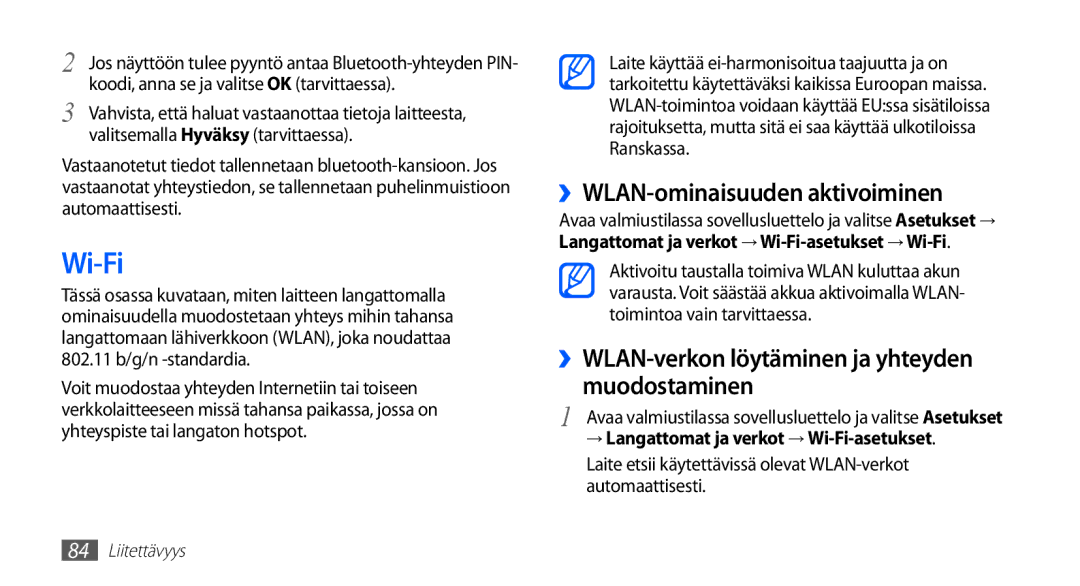Kies ohjelman asennus PC Sync
Käyttöopas
Lue tämä ensin
Tämän oppaan käyttäminen
Säilytä tämä opas tulevaa käyttöä varten
Ohjekuvakkeet
Huomautus huomautuksia, käyttövinkkejä tai lisätietoja
Tarkoittaa virta/lukituspainiketta
Tavaramerkit
Tekijänoikeus
Kokoaminen
Sisältö
Viihde
Työkalut
Vianmääritys 107
Pakkauksen avaaminen
Kokoaminen
SIM- tai USIM-kortin ja akun asentaminen
→ OK
SIM- tai USIM-kortin ja akun asentaminen
Varo, ettet vahingoita kynsiäsi irrottaessasi takakantta
Aseta akku paikalleen Aseta takakansi takaisin
Akun lataaminen
Kytke laturin iso pää pistorasiaan
››Akun lataaminen laturilla
››Lataaminen PC-datakaapelilla
Muistikortin asentaminen
Monitoimiliittimeen
Porttiin
Kokoaminen
››Muistikortin alustaminen
››Muistikortin poistaminen
Vedä muistikortti pois muistikorttipaikasta
Sulje muistikorttipaikan kansi
Käsihihnan kiinnittäminen
››Puhelimen osat
Aloitusopas
Laitteen kytkeminen päälle Paina jonkin aikaa -painiketta
››Näppäimet
Kuvake Selitys
››Ilmoituskuvakkeet
Puhelu kesken
Kellonaika
Kosketusnäytön käyttäminen
Voit ohjata kosketusnäyttöä seuraavilla toimilla
Älä käytä teräviä esineitä, jotta et raavi kosketusnäyttöä
→ Näyttö → Näytön aikakatkaisu
››Kohteiden lisääminen valmiusnäyttöön
Valmiusnäyttöön tutustuminen
Paina
Aluetta jonkin aikaa
››Valmiusnäytön kohteiden siirtäminen
››Pikanäppäinpaneelin käyttö
››Valmiusnäytön kohteiden poistaminen
Muuttuu harmaaksi
Paina valmiustilassa → Muokkaa
Sovellusten käyttäminen
Paina lopuksi
Puhelimen sovellusten käyttäminen
››Äskettäin käytettyjen sovellusten käyttäminen
››Sovellusten järjestely
→ Tallenna
››Tehtävienhallinnan käyttö
Laitteen mukauttaminen
››Kellonajan ja päivämäärän määrittäminen
››Kosketusäänen kytkeminen päälle ja pois
››Soittoäänen vaihtaminen
››Siirtyminen äänettömään tilaan
››Animaation ottaminen käyttöön ikkunaa vaihdettaessa
››Valmiusnäytön taustakuvan valinta
››Määritä näytön lukitus
››Näytön kirkkauden säätäminen
→ Näyttö → Kirkkaus
Valitse Jatka
Lukituksen avauksen PIN-koodin määrittäminen
››SIM- tai USIM-kortin lukitseminen
Lukituksen avauksen salasanan määrittäminen
Lukitse SIM-kortti
››Näppäimistön tyypin vaihto
Tekstin kirjoittaminen
››Tekstin syöttäminen Swype- näppäimistöllä
Voit lisäksi käyttää seuraavia näppäimiä Numero Toiminto
››Tekstin kirjoittaminen Samsung- näppäimistöllä
Valitse → Näppäimistön tyypit ja valitse
Tekstinsyöttötapa
Numero Toiminto
Oikealle
››Tekstin kopiointi ja liittäminen
Sovellusten lataaminen Android Marketista
››Sovelluksen asentaminen
Etsi tiedosto tai sovellus ja lataa se
Tietojen synkronointi
Tiedostojen lataaminen verkosta
››Sovelluksen asennuksen poistaminen
Tuntemattomat lähteet
››Automaattisen synkronoinnin kytkeminen päälle
››Palvelintilin määrittäminen
››Tietojen synkronointi manuaalisesti
→ Tilit ja synkronointi
Soittaminen
Yhteydenpito
››Soittaminen ja puheluun vastaaminen
››Valintojen käyttäminen puhelun aikana
››Kuulokemikrofonin käyttäminen
Soittaja kuulee varattu-äänen
Näppäintä
Voit avata numeronvalintanäytön valitsemalla Näppäimistö
››Lisäominaisuuksien käyttäminen
→ Puheluasetukset → Puhelunsiirto
››Puhelulokien lukeminen
Päälle
››Tekstiviestin lähettäminen
Viestinvälitys
››Multimediaviestin lähettäminen
››Teksti- ja multimediaviestin lukeminen
››Vastaajaviestien kuunteleminen
››Sähköpostiviestin lähettäminen
Google Mail
Mail
Paina → Viestin kirjoitus
››Sähköpostitilin määrittäminen
Sähköposti
››Sähköpostiviestien järjesteleminen nimikkeiden avulla
Valitse Muuta tunnisteita
Noudata näyttöön tulevia ohjeita
››Sähköpostiviestin lukeminen
→ sähköpostitili Paina → Luo
››Ystävien lisääminen ystäväluetteloon
Talk
Paina → Lisää ystävä
››Keskustelun aloittaminen
Social Hub
Kamera
Viihde
››Valokuvan ottaminen
Voit lähettää valokuvan muille valitsemalla Jaa
Valokuva tallentuu automaattisesti
››Kuvien ottaminen eri näkymille esiasetetuilla asetuksilla
››Kuvien ottaminen hymykuvaustilassa
››Panoraamakuvan ottaminen
››Valokuvasarjan ottaminen
Vastapäivään Valitse
Vapautat painikkeen
››Kameran asetusten mukauttaminen
››Videon kuvaaminen
Tarkista videokameran tila ja asetukset
Käyttöösi seuraavat asetukset Vaihtoehto Toiminto Ajastin
Niin saat
Alkaa tallentaa videota
Ja mustavalkoisia sävyjä
››Tuetut tiedostomuodot
Galleria
››Valokuvan katseleminen
Tyyppi Muoto Kuva
››Videon toistaminen
Musiikki
››Kuvien ja videoiden jakaminen
››Musiikin toistaminen
››Musiikkitiedostojen lisääminen laitteeseen
Voit ohjata toistoa seuraavilla näppäimillä
Kanavaisen tilaääniäänijärjestelmän
Selaa tiedostoa taaksepäin kosketa jonkin aikaa
››Soittolistan luominen
Valitse musiikkiluokka → musiikkitiedosto
→ Lisää toistoluetteloon → Uusi
››Satunnaissoitto-ominaisuuden käyttö
→ Juhlasatunnaistoisto
Juhlasatunnaistoisto ei käytössä
››FM-radion kuunteleminen
FM-radio
Paina → Hae → hakuvaihtoehto
››Radioaseman tallentaminen automaattisesti
››Radioaseman lisääminen suosikkiluetteloon
››FM-radioasetusten mukauttaminen
››Yhteystietojen luominen
Yhteystiedot
Nronäpp
››Pikavalintanumeron määrittäminen
››Yhteystietojen etsiminen
››Käyntikortin luominen
››Yhteystietojen noutaminen yhteisötileiltä
››Yhteystietojen kopioiminen
››Yhteystietoryhmien luominen
››Yhteystietojen tuominen ja vieminen
Ryhmät
››Tietoliikennelokin tarkasteleminen
Kalenteri
››Sosiaalisen verkoston toimintojen esittäminen
››Tapahtuman luominen
››Tapahtumien katselu
Muistio
››Muistion luominen
››Tapahtuman hälytyksen sammuttaminen
››Muistioiden lukeminen
Puhemuistio
››Puhemuistion äänittäminen
Puhemuistio
Valitse Luett
››Puhemuistion toistaminen
Valitse toistettava puhemuistio
Jaa → vaihtoehto
Internet
Verkkotoiminnot
››Verkkosivujen selaaminen
→ Lisää kirjanmerkki
Päiv
→ Sivutiedot
››Kirjanmerkin määrittäminen suosikkisivustoille
››Tietojen etsiminen ääniohjauksella
Valitse → Kirjanmerkit
Katsottu sivu kirjanmerkillä
››Viime sivustojen ja viime historian käyttö
Maps
Valitse → Käydyimmät tai Historia
Valitse käytettävä verkkosivu
››Tietyn sijaintipaikan etsiminen
››Sijainnin jakaminen Google Latitude -palvelulla
››Ohjeiden hakeminen tiettyyn määränpäähän
››Navigointi määränpäähän
››Lähistöllä olevan paikan etsiminen
YouTube
Google Search
››Videoiden katselu
Navigation
Tallenna
››Videoiden lähettäminen verkkoon
Sisään
››Säätietojen lukeminen
Uutiset ja sää
››Uutisartikkelien lukeminen
Sää
Market
Samsung Apps
BookStore
MusicStore
››Langattoman Bluetooth-ominaisuuden kytkeminen päälle
Bluetooth
→ Langattomat ja verkot → Bluetooth-asetukset
Liitettävyys
Tarkista laitteet
››Tietojen vastaanottaminen langattoman
››WLAN-ominaisuuden aktivoiminen
Wi-Fi
››WLAN-verkon löytäminen ja yhteyden muodostaminen
››WLAN-verkon lisääminen manuaalisesti
AllShare
››Tiedostojen toistaminen toisella Dlna
››Laitteen tiedostojen toistaminen toisella laitteella
Soittimella puhelimen kautta
Laite jakaa matkapuhelinverkkoyhteyden tietokoneen kanssa
Matkapuhelinverkon jakaminen
››Yhteyden muodostaminen Samsung Kies -ohjelmalla
Tietokoneyhteydet
››Liittäminen massamuistilaitteena
VPN-yhteydet
››VPN-yhteyksien määrittäminen
Määritä VPN
Vaihtoehto Toiminto VPN-nimi
Käyttöön Salattavaksi Internetistä
Anna esijaettu avain
Avaa valmiustilassa sovellusluettelo ja valitse Asetukset
››Yhteyden muodostaminen yksityisverkkoon
Kello
Työkalut
››Kellon käyttö
››Uuden hälytyksen määrittäminen
Lataukset
Laskin
Omat tiedostot
Lisäasetuspaneeli
Tehtävienhallinta
SIM-työkalut
Voit käyttää seuraavia vaihtoehtoja painamalla kansiossa
Voit luoda uuden kansion valitsemalla L. kansio
››Uuden asiakirjan luominen
ThinkFree Office
Laitteella
››Asiakirjan esittäminen ja muokkaaminen
››Asiakirjojen käsittely verkossa
Äänihaku
Valitse Verkko
Kirjaudu sisään
Asetusvalikon käyttö
Asetukset
Langattomat ja verkot
››Yhdist. ja siirr. tukiasema
Puheluasetukset
››VPN-asetukset
››Matkapuhelinverkot
››Vastaajapalvelu
Ääni
››Vastaajan numero
››Puhelunsiirto
Sijainti ja suojaus
Näyttö
Muuta näytön asetuksia
Kirkkaus Määritä näytön kirkkaus
Ei mitään Kytke näytön lukitus pois käytöstä
Sovellukset
PIN Määritä PIN-koodi numeerinen, jolla voit avata näytön
Määritä SIM-kortin lukitus
Kehitys
Tilit ja synkronointi
Alue ja teksti
Yksityisyys
››Valitse kieli
››Valitse syöttötapa
Syöttökielet Valitse tekstinsyöttökieli
››Samsung-näppäimistö
››Puheentunnistuksen asetukset
Äänitulo ja -lähtö
››Teksti puheeksi -asetukset
Opetusohjelma Opi kirjoittamaan Samsung- näppäimistöllä
Päivämäärä ja aika
Helppokäyttöisyys
Tietoja puhelimesta
Muuta helppokäyttöisyysasetuksia
Lukitse SIM-kortti-valikossa
Vianmääritys
Laite jumiutuu tai tapahtuu vakava virhe
Varmista, että laitteen virta on kytkettynä
Varmista, että olet painanut soittopainiketta
Varmista, että et peitä laitteen sisäistä antennia
Näppäile ja tallenna numero tarvittaessa uudelleen
Lataa akku tai vaihda se täysin ladattuun akkuun
Akku ei lataudu kunnolla tai laite sammuu
Tarkista, että laite tukee tiedostotyyppiä
FM-radion käynnistyessä näyttöön ilmestyy virheilmoitus
Laite ei löydä toista Bluetooth-laitetta
Varoitus Estä sähköisku, tulipalo ja räjähdys
Turvallisuusohjeet
Sammuta laite, jos sen käyttö kielletään
Käytä hands-free-laitetta
Matkalaitteen asianmukainen hoito ja käyttö
Varmista akun ja laturin pitkäikäisyys
Älä pidä laitetta takataskussa tai vyöllä
Specific Absorption Rate SAR -tiedot
Tuotteen turvallinen hävittäminen
Vastuuvapauslauseke
Hakemisto
107
Kamera
Tilien määrittäminen
Puhelut
Multimediaviestien
Valokuvat
Page
Vaatimuksenmukaisuusvakuutus R&TTE
GSM Wcdma Wi-fi matkapuhelin GT-S5830
Me,Samsung Electronics

